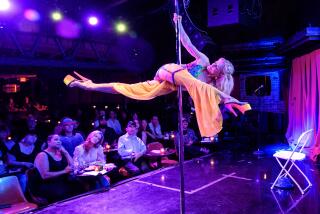Celebrated Russian ballerina Maya Plisetskaya dies at 89

- Share via
Maya Plisetskaya, the celebrated Russian ballerina famous for her swan-like arms, powerful leaps and rebel spirit on and off the stage, has died. She was 89.
The cause of her death Saturday in Munich, Germany, was a heart attack, Bolshoi director Vladimir Urin told the Russian state news agency Tass. Plisetskaya had lived in Germany since the collapse of the Soviet Union.
The French ballet critic André Philippe Hersin once summed up her style in three words: “genius, audacity and avant-garde.” Considered the embodiment of the Bolshoi style, she was renowned for passionate performances that contrasted with the ethereal style of many other dancers.
Tragic roles were considered her forte. Among the parts most associated with her were Carmen, Anna Karenina, Odette/Odile, and the Dying Swan.
“The Dying Swan” was created by choreographer Mikhail Fokine in 1905 for Anna Pavlova, who was considered its most brilliant interpreter until Plisetskaya.
Mikhail Baryshnikov wrote on Facebook on Saturday of “her amazing Dying Swan” from 1959 and 1986, noting that in the latter performance the ballerina was already 61.
Plisetskaya, he added, was “one of the greatest dancers of our time … beautiful and graceful.”
Born in Moscow on Nov. 20, 1925, she grew up in a theatrical family. Her mother, Rakhil Messerer, was a noted silent-film actress. Her aunt and uncle, Sulamith and Mikhail Messerer, were gifted soloists who later taught at the Bolshoi.
A restless child who, according to her aunt, “just can’t help dancing,” Plisetskaya was 9 when she was admitted to the Moscow Choreographic School, where most Bolshoi dancers receive their early training. Immersed in a grueling, six-day-a-week schedule of lessons, she quickly demonstrated technical skill as well as a daunting individualism that earned her a brief expulsion.
“The happiest moment of my life was when I was thrown out of class,” she recalled in the New York Times in 1987. “I was free to do what I wanted while the others were suffering in class.”
Ballet became a refuge when the Stalinist purges of the 1930s tore her family apart. Her mother was sent to a labor camp and later exiled, while her father, a mining official and diplomat, was executed. Both were Jewish. Plisetskaya wrote in her autobiography, “I, Maya Plisetskaya” (2001), that the reason for the persecution was her father’s friendship with a former aide to Stalin enemy Leon Trotsky.
Plisetskaya was branded a “daughter of an enemy of the people” and left with a lasting distaste for the Soviet system. Yet, unlike famous colleagues who later defected (including Baryshnikov, Rudolf Nureyev and Plisetskaya’s partner, Alexander Godunov), she always returned to Russia.
“She was the prima ballerina who could not tour with her company, the anti-Soviet who would not emigrate,” Russian dance historian Tim Scholl wrote in a foreword to her memoir.
Plisetskaya wrote that she would prefer to talk about the dance, “about my battements and my handsome partners. But whichever way I look at my childhood, it all revolves around politics and Stalin’s terror.”
Eighteen when she joined the Bolshoi and 35 when she succeeded Galina Ulanova as prima ballerina, the strikingly beautiful redhead blazed a path to superstardom that stretched over five decades. One of the first ballerinas to take classes with the men, she became famous for her muscularity, intensity and impressively supple spine.
“I tried to do classical dances in my own modern way,” she told the New York Times in 1996. “I jumped like no one before me. The Bolshoi did not like it. They said I was like a circus performer, but I did it anyway.” She was finally allowed to tour in the West in the late 1950s, but it was not the glamorous experience some might have expected. Although her account was disputed by others, she wrote in her book that before setting out for America she and the other dancers packed their suitcases with food because they were paid too poorly to eat out. And when their supplies ran out, they bought cat and dog food.
“You felt very strong after animal food,” the ballerina wrote, recalling how she and other dancers “fried canine beefsteaks between two hotel irons.”
In case these temptations proved too strong, Soviet officials ensured Plisetskaya’s return by forcing her husband, composer Rodion K. Shchedrin, to stay behind in Moscow.
She remained a sharp critic of Bolshoi management and Soviet rule. She often clashed with Bolshoi director Yuri Grigorovich, calling him “the tyrant.” She was among two dozen prominent figures, including dissident Andrei Sakharov, who in 1964 warned Premier Leonid Brezhnev against a return to Stalinism.
Eventually, she was allowed to create ballets and direct other companies, including the Spanish National Ballet and the Rome Opera Ballet. In 1990, when she was 65, she retired from the Bolshoi and later moved to Germany with her husband, who had joined the Bavarian Music Academy. She continued to perform for more than another decade, including a 75th birthday performance in 2000.
In 1988, New York Times critic Anna Kisselgoff wrote in a review that “no ballerina has thrilled (the word is used advisedly) me as much as Maya Plisetskaya. There are others one might prefer for reasons of purity and style. But no female dancer made classical dancing as exciting as Ms. Plisetskaya, and this was not, as has been wrongly charged, because she threw form and discipline to the wind.”
Besides her husband, she is survived by a brother, dancer-choreographer Azari Plisetsky.
Associated Press contributed to this story.







